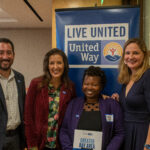Search
Calls and texts to United Way Bay Area for assistance on its 211 helpline over the prior 90-day period highlight a persistent need for resources, with call and text volumes consistently exceeding pre-pandemic levels
February 2, 2024
MEDIA CONTACT:
Blake Case
(601) 832-6079
blake@emccommunications.com
San Francisco, February 5, 2024 — Today, United Way Bay Area — one of the most respected and highly effective philanthropic organizations fighting poverty in the region — released its quarterly 211 Helpline Snapshot’ report, featuring data on the calls and texts the nonprofit’s essential 211 call center received from Bay Area residents reaching out for help from October through December, 2023. United Way Bay Area’s 211 Helpline is a free, vital service that connects callers with health and human services throughout the Bay Area.
According to the report, 10,577 calls or texts for help came in to 211 during the 90-day period. The number of calls coming into 211 in Q4 of 2023 were up 42% compared to Q4 of 2019; overall, calls to the United Way Bay Area 211 Helpline in 2023 were up 16% from the pre-pandemic baseline. These numbers highlight that the pandemic emergency didn’t just push more people to call for help during the pandemic, it cemented 211 even further as an essential helpline in our communities.
“Though call and text volumes are down from their historic peak during the pandemic, the community’s reliance on 211 has not gone back to normal,” said Clare Margason, United Way Bay Area’s 211 Helpline Director. “Our neighbors are relying on 211 resources at a level that we did not witness before the pandemic, emphasizing the importance of additional support and resources for the 211 network across the state.”
Housing remains the number one reason neighbors contacted 211 over the past five years, though the number and overall share of calls from neighbors seeking help to get or remain housed has only grown over this time period. The top five reasons that community members seek assistance have also remained consistent, except for a sharp rise in calls for help affording utility (electricity, heat, cooling, and internet) costs ranked among the top 5 concerns for the first time in 2023. This change can be attributed to the rise in utility costs across the state in recent years.
Over 600,000 Bay Area households, or 25% of all households, don’t earn enough to cover the basics each month: food, housing, childcare, transportation, and healthcare. A family of four needs $110,000 per year to cover basic needs, but two adults working full-time for minimum wage only earn $62,400 per year. Federal poverty programs cut off assistance once a family earns over $27,750 per year, leaving about 20% of Bay Area residents struggling to fill the gap.
United Way Bay Area’s complete 211 dashboard is available online.
To speak with United Way Bay Area 211 Helpline Director Clare Margason, contact Blake Case at blake@emccommunications.com or (601) 832-6079.


